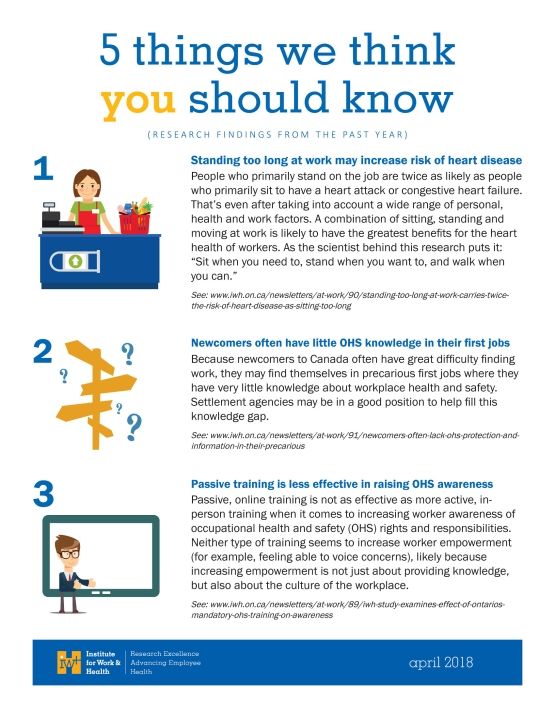
Standing too long at work may increase risk of heart disease
People who primarily stand on the job are twice as likely as people who primarily sit to have a heart attack or congestive heart failure. That’s even after taking into account a wide range of personal, health and work factors. A combination of sitting, standing and moving at work is likely to have the greatest benefits for the heart health of workers. As the scientist behind this research puts it: “Sit when you need to, stand when you want to, and walk when you can.”

Newcomers often have little OHS knowledge in their first jobs
Because newcomers to Canada often have great difficulty finding work, they may find themselves in precarious first jobs where they have very little knowledge about workplace health and safety. Settlement agencies may be in a good position to help fill this knowledge gap.

Passive training is less effective in raising OHS awareness
Passive, online training is not as effective as more active, in-person training when it comes to increasing worker awareness of occupational health and safety (OHS) rights and responsibilities. Neither type of training seems to increase worker empowerment (for example, feeling able to voice concerns), likely because increasing empowerment is not just about providing knowledge, but also about the culture of the workplace.

Little is known about the impact of marijuana use on workplace health and safety
Recreational marijuana is set to be legalized in Canada in 2018, yet evidence on the impact of marijuana use in the workplace is scant. Studies examining marijuana use and workplace outcomes such as work absenteeism, job turnover, disciplinary measures, workplace accidents and injuries, and interpersonal conflict have produced mixed results. And very few studies have looked at marijuana and safety-sensitive situations at work. Conducting research in this field is difficult because, while we can test for use, we can’t yet reliably test for impairment.

Participatory ergonomics can help build positive safety culture
The implementation of a participatory ergonomics program called Employees Participating in Change (EPIC) at a long-term care home north of Toronto has resulted in a marked shift in safety culture. Front-line staff are reporting hazards as they arise and expect them to be corrected. The result? Lost time due to workplace injuries is down significantly.
